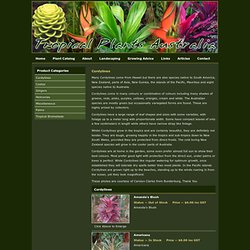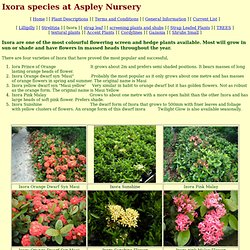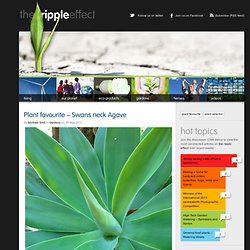

Australian Tropical Plants. Many Cordylines come from Hawaii but there are also species native to South America, New Zealand, parts of Asia, New Guinea, the islands of the Pacific, Mauritius and eight species native to Australia.

Cordylines come in many colours or combination of colours including many shades of greens, reds, pinks, purples, yellows, oranges, cream and white. The Australian species are mostly green but occasionally variegated forms are found. These are highly prized by collectors. Cordylines have a large range of leaf shapes and sizes with some varieties, with foliage up to a meter long with proportionate width.
Some have compact leaves of only a few centimeters in length while others have narrow strap like foliage. Whilst Cordylines grow in the tropics and are certainly beautiful, they are definitely not tender. Cordylines are at home in the garden, some even prefer almost full sun to show their best colours. These photos are courtesy of Carolyn Clarke from Bunderburg, Thank You Cordylines. Cordyline. Bird of paradise. Dwarf ixora. Ixora. There are four varieties of Ixora that have proved the most popular and successful, Iora Prince of Orange It grows about 2m and prefers semi shaded positions.

It bears masses of long lasting orange heads of flower. Ixora Orange dwarf syn 'Maui" Probably the most popular as it only grows about one metre and has masses of orange flowers in spring and summer. The original name is Maui Ixora yellow dwarf syn "Maui yellow' Very similar in habit to orange dwarf but it has golden flowers.
Not as robust as the orange form. This is a photo of Ixora orange dwarf at my home. During summer most of the hedge is in full sun and in winter part shade. I find it very easy to maintain, I lightly prune it every 4 months (excluding when buds are set and that's about it. Mondo grass. Savewater.com.au - savewater!® plant selector - Mondo Grass - Ophiopogon japonicus. Creeping booblia. Kangaroo paw. Gazanias. Nandina. Agave. Savewater.com.au - savewater!® plant selector - Creeping Boobialla - Myoporum parvifolium. Savewater.com.au - savewater!® plant selector - Pixie Dwarf or Gazanias - Gazania sp. Anigozanthos or Kangeroo Paw. Savewater.com.au - savewater!® plant selector - Search results.
Plant favourite – Swans neck Agave. Agave a go go ...but why 'swan's neck'?

The word Agave comes from the Greek for ‘noble’ and Agave attenuata has a striking and much loved form of large green rosettes with pointed tips. Some people adore succulents, let me say this is certainly a good one even if you are not a fan. Originating in Mexico and seriously drought tolerant it grows across most of Australia, is salt and wind tolerant and looks particularly good as a feature plant with stone, gravel or sand. It needs good drainage so make sure it doesnt have wet feet. It does quite well as a feature plant in pots so its well suited to the modern minimalist look. I have always been curious about the names associated with this plant. You can find this plant and lots of our other favourites on the savewater! School Gardens. When planning such a project, interest and enthusiasm are vital to its success.

It should be seen as an ongoing program which is closely linked with many other aspects of the school's curricula. The coordinating teacher(s) need to be prepared to dedicate a considerable amount of time to the project for several years overseeing the area and educating and instructing students, other teachers and adults in the associated programs. Once the project is established it can become self-perpetuating. The following are some ideas which may help you to begin your project. Plants can be chosen and arranged in many different ways to suit many different purposes.
Suggested ideas are: These areas can be made quite simply. Cox, Denis, Ian McMaster and John Obuch, Victorian Schools Nursery,Grounds for Learning: a practical guide to schoolground use and development, Dellasta, 1990. Leiper, Glen, Mutooroo: Plant use by Australian Aboriginal people, [school garden], Eagleby South State School, Eagleby, 1984. Gardening Australia - Fact Sheet: Gardening Around Palms. Leonie Norrington offers advice how to garden creatively under palms Presenter: Leonie Norrington, 17/10/2009 SERIES 20 Episode 38 Palms look beautifully tropical and bring welcome shade to a garden.

They're also highly recognisable as their own distinct family, Arecaceae. Although they're sometimes referred to as trees they're actually monocots. However, although their foliage is lush and attractive, palms can be a problem in the garden because it's almost impossible for other plants to grow in the ground below the canopy.